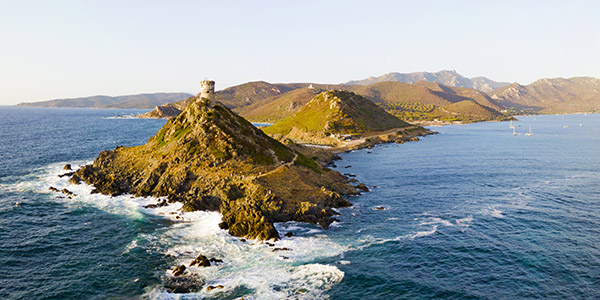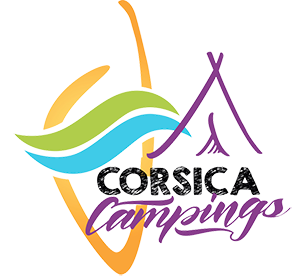Bloodthirsty Road
The D111 leads onto the Route des Sanguinaires, and ends at Pointe de la Parata with its Tourgénoise, which dates from 1608. It is accessible via a fairly easy walk, approximately 40 minutes round trip. Below the road, there is the possibility of stopping on the beaches of Saint-François or Trottel for example. In 1632 the Chapel of the Greeks was built, 500m further from Trottel beach. For the more sporty, don’t hesitate to take the Sentier des Crêtes, departing from Ajaccio, for a 3-hour hike to reach the rocky archipelago.
Ajaccio
In Roman times, the city was called Adjacium, which meant ‘quiet place’. It was during the 15th century and the arrival of the Genoese that the city expanded and many buildings were created, such as the Citadel. Under the reign of Napoleon, the city was declared the capital of Corsica. After passing the Citadel, we arrive at the marina, where excursions depart to the Sanguinaires Islands or Bonifacio. Behind the town hall, on Campinchi square, a market is present every day of the week except Monday. From Place Foch, we head back towards Rue Cardinal Fesch and its pedestrian street with its many stores and boutiques. On the right, we see the Palais Fesch, built at the beginning of the 19th century, which bears the name of Cardinal Joseph Fesch, a member of Napoleon’s family. At his death, he had painted around 16,000 paintings, some of which are on display at the museum who carries his name. Rue Cardinal Fesch leads to Cours Napoléon, the city’s main commercial street. The route leads to Place du Diamant. In the heart of the old town, on rue Bonaparte, is the house where the emperor was born, which is now transformed into a museum.
Southern Gulf
In the southern part of the gulf, at the mouth of the Gravona river, you can admire an imposing Genoese tower, Campitello. It was the place of refuge for the Bonaparte family when they fled the city in 1793. Continuing the road, we arrive at Porticcio, a seaside resort. Its beaches and turquoise waters offer a panoramic view of the sea and the Ajaccian town in the distance. Porticcio is the Grosseto-Prugna marine, which is located a few kilometers inland. The Saint-Césaire church was built in the center of the village during the 11th century. The best-known beaches of Porticcio are that of Capitello (at the entrance to the village) or La Viva, located in the town center. Going back towards the hinterland, the route leads to Acqua Doria, where there is one of the most beautiful views of the Gulf of Ajaccio. Then, we arrive at Capu di Muro, where a hike begins towards a Tourgénoise which bears the same name. The road continues towards the Gulf of Valinco.
Gravona Valley
From Ajaccio, on the road leading to Bastia, you can admire the Gravona valley. On the other side we can see Monte Gozzi. Although the path is longer, do not hesitate to take the path that leads to the villages of Pedi-Morella, Cuttoli and Peri. The valley is also home to the A Cupulatta turtle park, founded in 1993 by Philippe MAGNAN, where more than 170 different species of turtles are listed. It is open from April 1 until October 31. During the winter, the park is closed due to species hibernation. Still on the road to Bastia, near the village of Bocognano, the D27 will take you to the Cascade du Voile de la Mariée. From the road, continue on foot for 3.3km to get to the highest waterfall on the island (125m). The village organizes the Chestnut Fair every year in December. Nearly 150 exhibitors are present during the weekend and it is one of the most famous and oldest fairs in Corsica. Leaving Bocognano, a road passes through the villages of Busso and Richjusa, where the Gravona flows. .Numerous swimming pools await you to cool off or practice white water sports. The Richjusa canyon is one of the best known and favorite in Corsica.
Prunelli Valley
From Ajaccio, the valley is accessible from the N193, then the N196 after passing the airport. The road climbs for 15km towards the village of Ocana. Once you have passed the Mercujo pass, you arrive at the Tolla artificiality. Passing the pass, you have a view of the entire Prunelli valley and its gorges. After the village of Tolla, we cross the Prunelli gorge, and it is possible to stop near the river to enjoy the basins. We then arrive on the D27 which goes up towards Bastelica. The village is known for its charcuterie, pigs are raised all around the village. If you go there during the first weekend of November you will discover the Nostra Mela Fair, a traditional autumn festival, where it is possible to taste cold meats and also other local products. The D27a continues towards the Ese plateau, where there is a downhill and cross-country ski resort.


